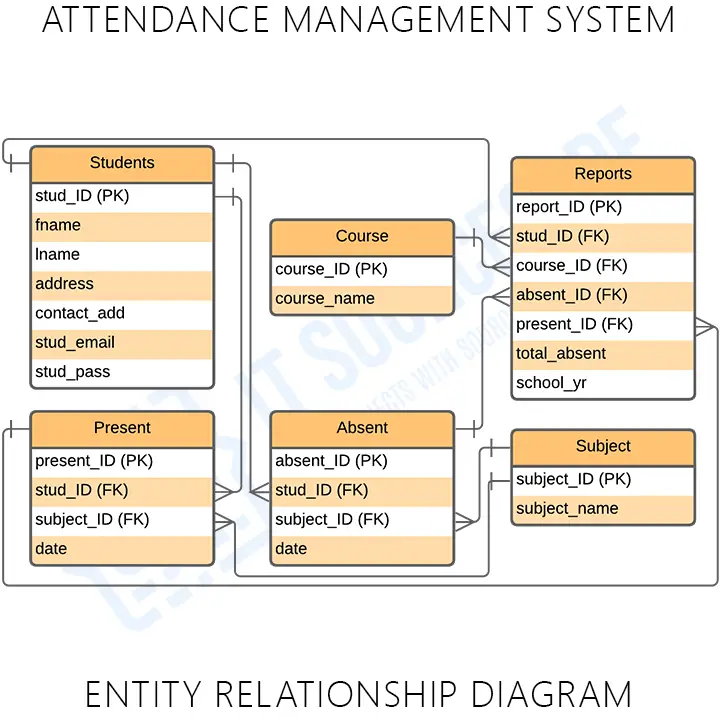The attendance management system ER diagram reveals the relationships of the system’s entities to create its database design. It is also used to describe the logical structure of the system’s database or data storage.
Designing an ER diagram is done by identifying the system’s entities, their properties, and interactions.
Moreover, the database design is sketched out using attendance management system ER diagrams. The database sketch then becomes the actual basis of the system’s data storage. This will also serve as the data destination and source.
Attendance Management System ER Diagram: Details
The table shows the overall description of the ER diagram for Attendance Management System. It has a complete overview of the project’s information.
| Name: | Attendance Management System ER (Entity-Relationship) Diagram |
| Abstract: | The attendance management system ER diagram draws the relationship between various entities. In fact, ERD is considered a blueprint of the system (project) structure. |
| Diagram: | ER Diagram is also known as Entity Relationship Diagram |
| Tools Used: | Diagraming tools that provide ER diagram symbols. |
| Users: | Website, Applications, and Software. |
| Designer: | ITSourceCode.com |
Attendance Management System Definition
An attendance management system allows teachers to track each student’s exact arrival time. The system then instantly notifies parents if a kid is absent. Teachers can also track attendance in their classes, report absences, and notify parents of their children’s absences by SMS and email.
Unlike traditional attendance systems, automatic attendance software allows professors to record, store, and monitor students’ attendance history while also efficiently managing the classroom.
Attendance Management System Features
- Attendance Management – is the main feature of the system. It contains the basic details in checking the student’s attendance.
- Student Management – it plays a big role in the system because. This gathers important information about the student. Then, they will be stored in the student database and will be used during the attendance checking.
- Manage Attendance Information – serves as the basis for the whole attendance report. This will also help in calculating the number of student absences for the School year or semester.
What is an ER Diagram?
The ER Diagram is referred to as the attendance management system’s database design. Both ER diagram and database design illustrate the relationships between all the system’s entities. Its major components are Entities, Attributes, and Relationships.
Additionally, the ER diagram is used to build and troubleshoot relational databases. It also works best with attendance management system DFD, which is responsible for data movement. Creating the attendance system database design would also be much easier with the help of ER diagram.
Importance of ER Diagram
The importance of ER diagram for attendance management system is to help in modeling its database design. It becomes the basis of the project’s database foundation for construction. This ERD also aids in defining the data types to be stored such as their attributes and characteristics.
In addition to that, the ER Diagram also describes how an entity interacts with other entities. The er diagram for attendance management system is used to display both details and attributes of a data store. It also lets us visualize how data is connected generically.
Entity-relationship diagrams are utilized in software engineering during the planning phase of software development. It aids in the identification of various system constituents and their interrelationships. This ER Diagram is also used as the foundation of the attendance system UML Diagrams.
ER Diagram for Attendance Management System
ER Diagram of Attendance Management System shows the system entity relationships in each entity and their supposed functions in each relationship.
Based on the image above, the ER diagram for Attendance System is presented in tables. The tables include student, course, subject, present, absent, and reports.
For instance, the tables are made to meet the required specification of the system and provide much more specific details of each entity within the system.
Attendance Management System ER Diagram Tables
These tables below provide the complete details such as Field Name, Descriptions, data types, and character lengths. Each of these tables represents the characteristics and the attributes of data storage.
Specifically, the field column presents the names of each database’s attributes, the description column gives the complete thought of each attribute, the type column is their data type and the length is for their character lengths.
Table Name: Student
| Field | Description | Type | Length |
| stud_ID (PK) | Student ID | Int | 11 |
| fname | Student First Name | Varchar | 255 |
| lname | Student Last Name | Varchar | 255 |
| gender | Student Gender | Int | 11 |
| age | Student Age | Int | 11 |
| contact_add | Contact Address | Int | 11 |
| stud_email | Student Email | Varchar | 255 |
| stud_pass | Student Password | Varchar | 255 |
Table Name: Subject
| Field | Description | Type | Length |
| subject_ID (PK) | Subject ID | Int | 11 |
| subject_name | Subject Name | Varchar | 255 |
| course_ID (FK) | Course ID | Int | 11 |
| stud_ID (FK) | Student ID | Int | 11 |
Table Name: Course
| Field | Description | Type | Length |
| course_ID (PK) | Course ID | Int | 11 |
| course_name | Course Name | Varchar | 30 |
Table Name: Present
| Field | Description | Type | Length |
| present_ID (PK) | Present ID | Int | 11 |
| stud_ID (FK) | Student ID | Int | 11 |
| subject_ID (FK) | Subject ID | Int | 11 |
| date | Date Present | Date |
Table Name: Absent
| Field | Description | Type | Length |
| absent_ID (PK) | Transaction ID | Int | 11 |
| stud_ID (FK) | Student ID | Int | 11 |
| stud_ID (FK) | Student ID | Int | 11 |
| date | Date of Absent | Date |
Table Name: Reports
| Field | Description | Type | Length |
| report_ID (PK) | Report ID | Int | 11 |
| stud_ID (FK) | Student ID | Int | 11 |
| absent_ID (FK) | Absent ID | Int | 11 |
| present_ID (FK) | Present ID | Int | 11 |
| total_absent | Total Absent | Int | 11 |
| school_yr | School Year | Int | 11 |
| course_ID (FK) | Course ID | Int | 11 |
All in all, the tables are given to be the basis for developers on how would they design the attendance management system database. It has a complete description of the database. Then the developers will put this into the program.
Attendance Management System ER Diagram [PDF]
The ER Diagram for Attendance Management System PDF explains the concepts of the project database. In fact, you may apply this information to your capstone project. You can also use it directly or modify its content depending on your project’s requirements.
How to create ER Diagram
Time needed: 5 minutes
Steps in building the ER Diagram for Attendance Management System with Cardinality Ratio.
- Step 1: Familiarize the ER Diagram Symbols and Cardinality
First, you need to familiarize the needed symbols.
ER Diagram Symbols:
• Fields: Fields are the parts of a table that define the entity’s characteristics. In the database that the ERD models, attributes are also known as rows.
• Keys is a technique to categorize data qualities. It is used to organize ER diagrams and assist users in modeling their databases. This is also used to connect different tables in a database.
– Primary Key: identifies a single entity instance which means a unique attribute or set of attributes.
– Foreign Key: is produced when data attributes have one too many relationships with other entities. - Step 2: Finalize the entities included
Second, design your ER Diagram by finalizing the entities that must be included in your attendance management system. This entity is represented by a rectangle.
- Step 3: Add the attributes of each entity
Next, is to add the attributes to each entity. Think about the qualities you’ll need to characterize an entity. The details of the various entities outlined in a conceptual ER diagram are supplied as attributes.
The entity’s attributes were represented by ovals and can be seen in the tables. Then, the design could be converted to the database of the system. - Step 4: Describe the relationships (cardinality) between entities and attributes
Finally, plot relationships between the entities.
A relationship is an association that describes how the entities interact. Additionally, the cardinality is indicated by a crow’s foot at the connector’s endpoints.
Specifically, one-to-one, one-to-many, and many-to-many are the three most common cardinal relationships. It’s the maximum number of times that one entity can be linked to another entity.
Conclusion:
In conclusion, the ER diagram is not only applied for Attendance Management System Database Design but also the foundation of other diagrams. This diagram is modeled to specify the exact destination and source of data.
Furthermore, the entity-relationship diagram (ERD) is considered a very important part of system development. That is because ERD serves as the project backbone. So, If you want more knowledge about ER Diagrams, you can also visit the Related Articles.
Related Articles:
- ER Diagram for Order Management System
- ER Diagram for Login Process
- Course Registration System ER Diagram
- ER Diagram for Login and Registration Page
- ER Diagram for Face Recognition Attendance System
Inquiries
If you have inquiries or suggestions about the Attendance Management System ER Diagram, just leave us your comments below. We would be glad to know to concerns and suggestions and be part of your learning.
Keep us updated and Good day!


